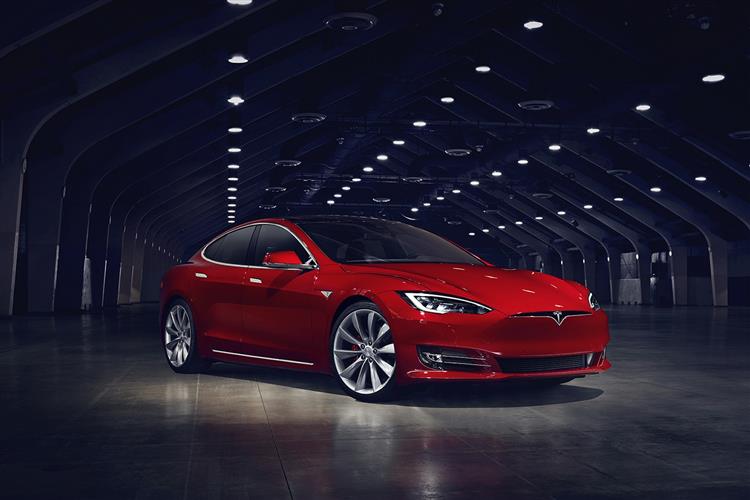What are the driving characteristics you’d look for in a big luxury car? We’d be looking for hushed refinement, a smooth step-off the line, instant acceleration as soon as you prod the throttle and the handling ability of a smaller car. The Tesla Model S delivers all of these things and more. The 2.2-tonne kerb weight hints at a rather portly demeanour but the Model S handles a good deal more sharply than you might imagine. The steering can be switched between three settings – Comfort, Normal and Sport – changing the weight of feel but not markedly adjusting the level of feedback. Ride quality is better than you’d expect from a vehicle running on 21-inch wheels. Air suspension is optional and worth having. As you’d expect from an EV, there’s no gearbox as such, so power transfer is even smoother than the best automatic transmissions.
That power comes courtesy of batteries developed by Panasonic which sit under the floor of the car, keeping the centre of gravity low, while the electric motor sits atop the rear axle. In the mainstream range, customers choose between 75 kWh and 100 kWh variants. Even with the 75 kWh version, sixty is just 4.2s away from rest, so you’ll be looking at very rapid progress. All derivatives get standard Dual Motor All Wheel Drive, which gives you get two electric motors, one sitting on the front axle, the other driving from the rear. With the power spread around the drivetrain, you’ve of course got the perfect recipe for AWD traction.

The same AWD set-up is used by the insane flagship ‘P100D’ variant. ‘Insane’ is a word we feel we have to use because it designates the most frantic of this top Tesla’s three driving modes – the others being ‘Normal’ and ‘Sport’. Go ‘Insane’ and 60mph is just 2.5s away from rest, courtesy of a 761bhp combined power output. As advertised, there’s nothing else with four or five seats that can get remotely close to this kind of pace.
Tesla deliberately set out to style this car in a relatively conservative fashion so as not to alienate its core buyers. There’s even a dummy air intake at the front. The car it most closely resembles in external dimension is a Porsche Panamera, but when you check the tape measure, you realise quite what a massive car this is. At 4978mm long, 1964mm wide and 1435mm high, it’s 8mm longer, 33mm wider and 17mm taller than a Porsche Panamera, which is already a pretty sizeable hunk of automotive real estate. The width makes it feel a handful on narrow city streets but there’s plenty of space inside.
The Tesla Model S is a remarkable vehicle. It changes the way you’ll view the whole concept of a motor car. As long as you are willing to alter your long-held preconceptions of what an automobile demands and, in turn, delivers, the Model S demonstrates that the genuinely practical electric vehicle has been achieved. Caveats are few. Yes, battery charging does require a little more thought than just topping up a tank and if a car is shared between a married couple for instance, you’ll both need to be on the ball with it.
Other than that, it’s a tour de force. The interior is adventurous, the packaging ingenious, the styling sleek and mature in its execution. It’s searingly rapid, wonderfully refined and rides and handles well. If this is the future of cars, bring it on. The internal combustion engine has had a good innings and certainly has charisma, but the Tesla Model S opens a window to a better way.



